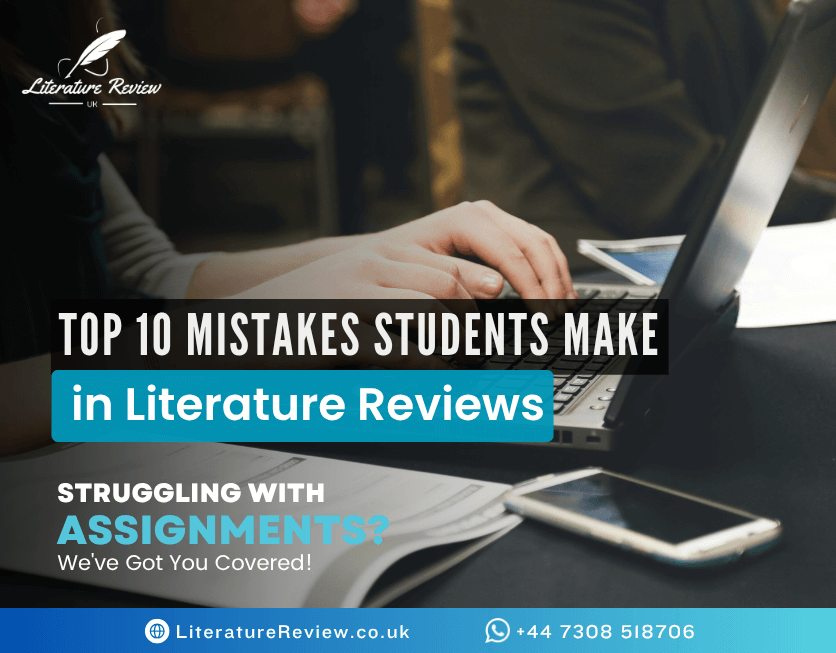
A literature review is a crucial part of academic writing, providing a foundation for research by analyzing existing studies. However, many students struggle with writing an effective literature review, often making avoidable mistakes that impact their grades. In this blog, we’ll explore the top 10 mistakes students make in literature reviews and how to fix them.
1. Lack of a Clear Research Focus
One of the biggest mistakes students make is failing to define a clear research focus. A literature review should be structured around a specific research question or objective. Without a clear focus, the review becomes vague and lacks direction.
How to Avoid:
- Define your research question before starting.
- Ensure every source you include is relevant to your topic.
2. Poor Organization and Structure
A well-organized literature review follows a logical structure. Many students simply list studies without connecting them, making it difficult for readers to follow the argument.
How to Avoid:
- Use a thematic, chronological, or methodological approach to structure your review.
- Create an outline before writing.
- Use subheadings to improve readability.
3. Ignoring Key Sources
Students often overlook seminal works in their field, relying only on recent studies. While new research is important, foundational studies provide essential context.
How to Avoid:
- Identify highly cited papers in your field.
- Use academic databases like Google Scholar, PubMed, and Scopus.
- Include a mix of classic and contemporary sources.
4. Overloading with Unnecessary Information
A literature review should be concise and relevant. Many students include excessive details about each study, making the review lengthy and unfocused.
How to Avoid:
- Summarize key findings instead of describing entire studies.
- Focus on how each study contributes to your research.
- Use bullet points for quick summaries.
5. Lack of Critical Analysis
A literature review is not just a summary—it requires critical analysis. Many students fail to evaluate the strengths and weaknesses of studies, leading to a superficial review.
How to Avoid:
- Compare and contrast different studies.
- Discuss gaps in research and areas for future study.
- Use phrases like “this study lacks empirical evidence” to highlight limitations.
6. Plagiarism and Improper Citations
Plagiarism is a serious academic offense. Many students unintentionally plagiarize by failing to properly cite sources.
How to Avoid:
- Use citation management tools like Zotero, Mendeley, or EndNote.
- Follow the required citation style (APA, MLA, Harvard, or Chicago).
- Paraphrase instead of copying text verbatim.
7. Failure to Identify Research Gaps
A strong literature review highlights gaps in existing research. Many students simply summarize studies without discussing what is missing.
How to Avoid:
- Ask: What hasn’t been studied yet?
- Identify contradictions or unanswered questions in the literature.
- Suggest future research directions.
8. Using Low-Quality Sources
Not all sources are credible. Many students rely on blogs, Wikipedia, or outdated studies, which weakens their review.
How to Avoid:
- Use peer-reviewed journals, books, and conference papers.
- Check the impact factor of journals.
- Avoid sources that lack author credentials.
9. Writing in a Passive and Unclear Style
A literature review should be engaging and well-written. Many students use passive voice and unclear phrasing, making their review difficult to read.
How to Avoid:
- Use active voice for clarity.
- Avoid jargon and overly complex sentences.
- Proofread using tools like Grammarly or Hemingway Editor.
10. Not Revising and Editing
Many students submit their literature review without proper editing and proofreading, leading to errors in grammar, structure, and citations.
How to Avoid:
- Take a break before revising.
- Use peer feedback to improve clarity.
- Run your document through plagiarism checkers like Turnitin.
Final Thoughts
Writing a literature review requires critical thinking, organization, and attention to detail. By avoiding these common mistakes, students can create a strong, well-structured review that enhances their research credibility.




